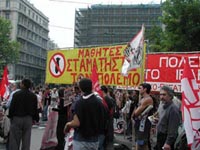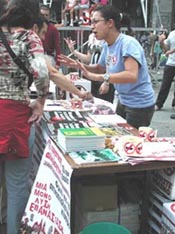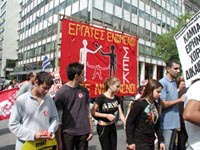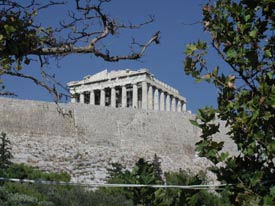 |
To the average visitor Athens is exciting: a city of light, history, and urban bustle. No traveler leaves without viewing traditional points of interest such as the Athenian acropolis or the vibrant plaka district or even the stately evzones guarding the Tomb of the Unknown Soldier. Snapping cameras repeatedly in the photo-perfect light of Greece, the tourists are unmistakable. The visitors hurry about, too, matching the urban bustle of Athens: tour guides deftly direct them to the target sites and back to waiting buses, trying to stay on schedule. For, if the travelers are to see all of the high points of Athens, then the guides must gently urge them along. Within just a two or three day stay, these eager tourists usually spend one-half day on the acropolis, several hours driving by points of interest, another half-day at one of the major museums, and another block of valuable time at the Temple of Apollo at Cape Sounion.
But to the observant traveler who wishes to pause to study and admire the “peplum” of Athena, a longer stay offers an ample reward. For it is only in this way that the artistry and folds of the “fabric” of Athens can really be appreciated.
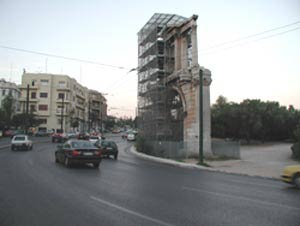 |
With just this purpose in mind, my husband and I decided to tarry in Athens last fall after finishing our business. Having no specific agenda on our schedule, we wandered throughout different parts of the city. Accustomed to the general traffic patterns from our previous trips, we quickly noticed the absence of ubiquitous taxi cabs and thorny traffic jams.
As we passed a colorful corner kiosk, we soon learned the reason for the decrease in traffic—strikes. Newspapers with bold headlines encircled the kiosk, suspended by clothespins. I smiled at such vocal expression by the Athenians. They were shrewd enough to air their protests in advance of the Olympics in order to pressure government officials to make a few concessions. And there was collusion among labor and trade groups, too, with each segment of the working populace supporting the other, astutely aware that timing was critical. For it would likely be some time before contract and labor disputes could easily be settled through negotiations or a few public strikes. And as we read in the local paper, the teachers had been working for a long period of time without a settled contract, prompting the unions and organizers finally to call for strikes. Taxi-drivers were protesting a proposed tax on their earnings. And other groups similarly were lodging their displeasure at proposed or recently enacted government fiscal reforms.
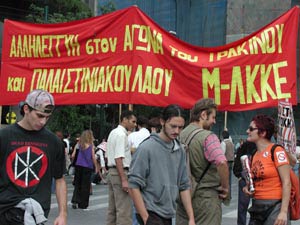 |
Our path eventually took us toward the center of the city, toward Constitution Square. Meandering leisurely along small side streets, we stopped when we spotted riot police ahead. The officers were in full uniform and were directing light traffic away from the main square. But we pedestrians were not discouraged from continuing. The sounds of voices over speakers grew ever louder as we approached the square. In the distance we could see throngs of people crowding the square and large banners and colorful placards everywhere. The mood of the filled square, we discovered, was not at all angry or violent, but one of urgent insistence and camaraderie. Not only was the populace joining in the protests of striking workers, but there was also a general anti-war protest taking place. Organizers earnestly called out their messages over loudspeakers and megaphones, trying to convince others of the correctness of their positions. Leading entertainers and musicians had been enlisted to aid the causes, with George Dalaras drawing thousands to a stage set up in the center of the square. Small groups marched about the square holding their boldly-lettered signs. Students handed out literature and pins. The Greeks, it was plain to see, are a very vocal and expressive people.
We walked about the square, taking in the sights and, when we had had enough, turned to retrace our steps. Back through the crowds, past the police lines several blocks away, and toward the Plaka. It was time for a meal. The afternoon light was now softer, bathing buildings along the narrow street with light shadows.
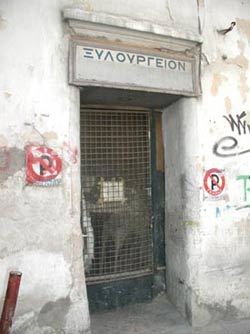 |
As we crossed a side street, we noticed that a tiny shop was open. There was nothing unusual about this storefront, if you could call it that, except that we happened to walk by it nearly every day and had never seen it open. In fact, on one occasion, we wondered if it had been closed permanently. We paused today, our interest now piqued, wondering what the products would be like. “Xylourgeion” was on the sign, signaling that this was the place of a woodworker. But one glance inside the opened door revealed that this shop was anything but a simple store.
Exquisitely hand-carved pieces of furniture, most of them ecclesiastical, sat just inside the door. There were icon stands, tables, screens, and more. These varnished, masterfully created pieces stood in sharp contrast to the humble interior of the shop and the distinct sounds of a rooster crowing out in the back. We were still gaping when an older gentleman came back into the front of the shop, bringing with him yet another magnificent piece of wood art
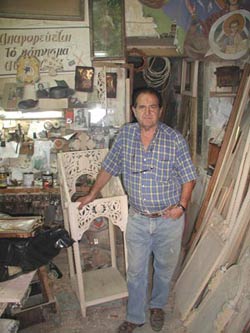 |
A little puzzled at first—apparently unused to answering the questions of “tourists” about his work—the gentleman soon began speaking freely to us. We had many questions for him. George was originally from the nearby island Aegina. A self-made man, he overcame very difficult hurdles as an orphaned youngster to become an apprentice to a boat builder. That was when, beginning at the age 12, he learned wood-working skills. He continued to hone his craft and after many lean years of financial struggles, eventually opened his own shop. “Even though life is still a challenge,” he said, “it’s much better for me now because I have plenty of food in my belly, some money, and I have the best children and grandchildren.” He recalled days in the 50s, during political strife, when times were difficult for everyone and there were many empty stomachs and much poverty. But, happily those days were long past, he told us. Very proud of his family, he offered us a business card of one of his sons in whose nearby shop his pieces were sold. He also pointed out the photos of his mother and family in high corners of the shop. It was time for him to retire, he declared, close his shop, collect his pension, and enjoy his children and grandchildren. As he stood amid his remarkable creations, we took in the entire sight and marveled at this man whose appearance seemed so simple, yet belied a significant artistic talent and expression.
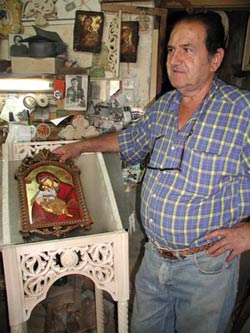 |
Here, we mused, was another fine example of Athenian expression. It contrasted in mode to the protests witnessed earlier, but it nonetheless revealed another curvaceous fold in the “peplum” of Athena. Within the space of one day we had witnessed both public and private expressions of thought and talent: public discourse in one case, art in the other. But they were connected in unrecognized ways, just as one elegant fold of drapery disappears and reappears in another area of the same fabric. The same cultural background pervaded both expressions, forming the essential fabric for the two spectacles observed that day. Political participation and vocal expression can lead to good government and thereby a good life for citizens. When artists and master craftspeople can earn a good living, they can produce fine examples of their artistic expression. As Athena moves, one elegant fold of her shimmering garment gives rise to another as her fluid gait propels her forward. Just so, as the city of Athens moves forward, one expression by her people is inextricably connected to another. And travelers who pause to appreciate the fluid movements of Athens will be richly rewarded by her colorful expressions.
Mary Papoutsy is a Classicist and former educator at the secondary and collegiate levels. She lectures on the Classics and Hellenic genealogy, having established the Hellenic Historical and Genealogical Association in 2000. Mrs. Papoutsy and her husband, Christos, are active members of Hellenic communities in the U.S. and elsewhere. Together they created the Christos and Mary Papoutsy Endowed Chair in Business Ethics at Southern New Hampshire University, the John C. Rouman Classical Lecture Series Endowment at the University of New Hampshire, and the Christos and Mary Papoutsy Vatoussa, Lesvos Revitalization Foundation. In 2000 they founded Hellenic Communication Service, and continue to serve as its publishers. For more information about Mr. and Mrs. Papoutsy, see the About Us section of the HCS Home Page at http://www.HellenicComServe.com.
(Posted 01 March 2004)
|




